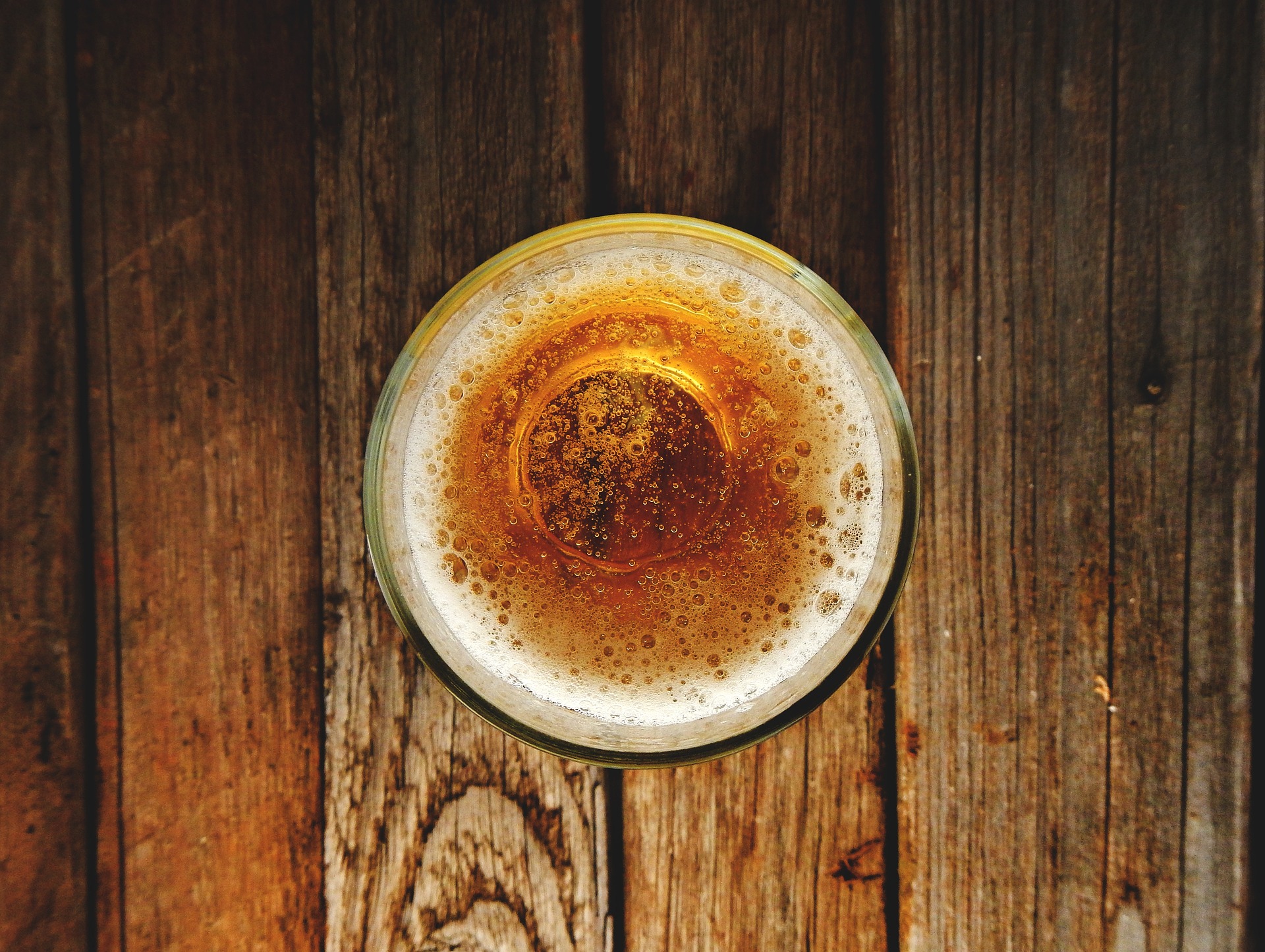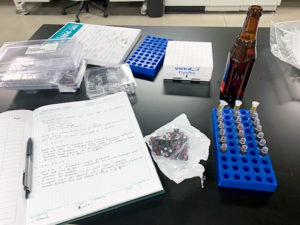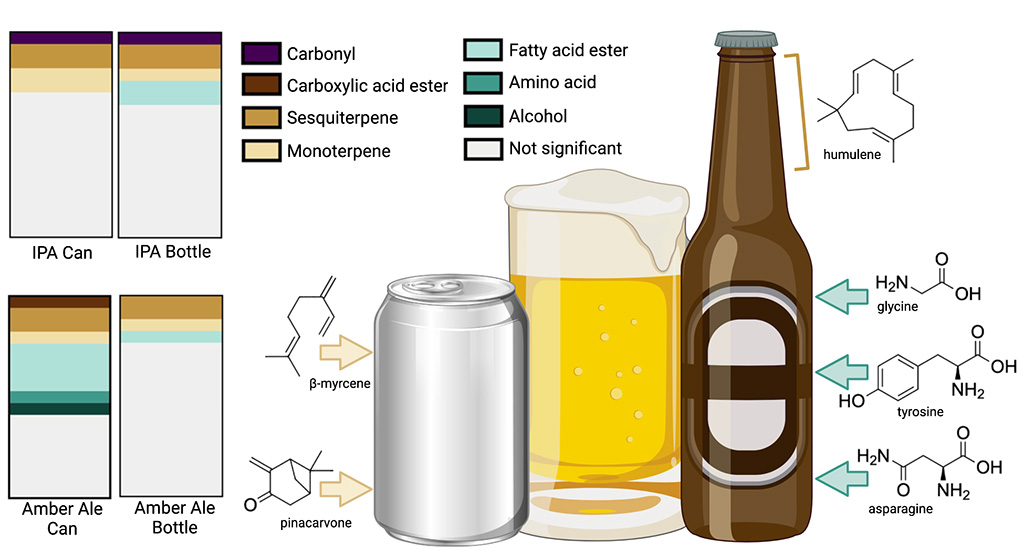
Fresh beer is the best beer, poured into a frosty glass mug right after production. And, old “skunky” beer is the worst. That is the usual standard.
But a Colorado State University study has shown that the chemical stability of how beer ages is likely dependent on beer style and packaging choice.
An amber ale aged better in bottles than in cans during a six-month period, researchers found. An India pale ale (IPA) aged the same in bottles or cans. The study used New Belgium’s Fat Tire amber ale and Voodoo Ranger IPA.
The study by researchers Katie Fromuth, Jacqueline Chaparro, Dana Sedin, Charlene Van Buiten and Jessica E. Prenni was published online by ACS Food Science & Technology just ahead of National Beer Day, April 7.
The authors noted that in 2020, there were 8,884 breweries in the United States, 120 of those being macro breweries. All the breweries produced 150 million barrels of beer, but sales by volume decreased 2.9%, meaning brewers increasingly need to win consumers and retain loyalty.
The researchers said that is done by matching products to consumer trends, packaging presentation through container type and label design and maintaining high quality and flavor stability.
“A quality beer that builds brand loyalty is one that is free from off-flavors and meets a certain degree of excellence across a complex set of sensory characteristics that are maintained across batches and over time,” the authors wrote.
The study involved chilling cans and bottles for a month and then keeping them at room temperature for five months, with analysis of metabolites in newly opened containers every two weeks.
Research showed the concentration of metabolites in amber ale was significantly different in cans versus bottles. IPAs were less affected by packaging, likely because of a higher concentration of polyphenols from hops.
“Ultimately the results show that neither cans nor bottles are outright better or worse for beer stability,” said Fromuth, who now works with the Brewers Association, the national trade organization for American craft beer. “Depending on the style, different flavor compounds will change over time and those changes are impacted by packaging type. What we learned is that it is a lot more nuanced.”
 Why were amber ales and IPAs chosen for this study?
Why were amber ales and IPAs chosen for this study?
“The majority of studies on beer stability are done on light lager styles, since traditionally this was the most abundant style of beer being produced and still is the case today for worldwide beer production,” said Fromuth, who had been director of the Fermentation Science and Technology Quality Lab in the Department of Food Science and Human Nutrition. “This limits our understanding of beer stability outside of this one style. Today, the American craft brewing industry, as well as the global brewing industry, produces a much more diverse array of beer styles and so the current body of beer stability literature doesn’t properly support today’s beer landscape. By choosing an IPA and amber ale, we aimed to expand the knowledge of beer stability as it relates to the American craft brewing industry today.”
What other styles should/could be tested in a similar way?
“Any and all of them!” Fromuth said. “If I were to have to choose, I would say hazy IPAs would be an ideal candidate for a similar study since it is such an important style in today’s industry. … I’d love to see this work continue and for others to build upon what me and my collaborators have learned.”
What is a ‘fresh’ beer, and when does it taste best?
“Broadly, I would define ‘freshness’ as how similar a beer is to its original flavor profile,” Van Buiten said. “The longer a beer is stored, the more its overall flavor (taste and aroma) will change, meaning that it will become less fresh. Our study shows that these changes are affected by the specific style of beer and the type of packaging used both affect these changes. The idea of when a beer tastes ‘best’ is a funny, subjective thing — there are so many things that can affect perception. Overall, consumers prefer fresh beer over products that are ‘skunked’ (also known as ‘light-struck’), but brand identity has been shown to have an impact on perception and liking of stale beer.”
Why/how does beer get skunky?
“There are two main types of chemical spoilage observed in beer – ‘skunked’ (also known as light-struck and stale), Van Buiten said. “The phenomenon of ‘skunking’ occurs when sunlight causes the oxidation of iso-alpha-acids – bitter-tasting compounds from hops — and allows them to react with sulfur-containing proteins in the beer. This forms a compound called 3-methylbut-2-ene-1-thiol, also known as MBT, which imparts the ‘skunky’ aroma. Packaging has a great influence on the development of MBT because different materials offer varying levels of protection against light ingress. For example, brown bottles offer much greater protection from light than green and especially clear glass, but aluminum cans don’t allow any light ingress at all.”


Did anyone taste-test the beer along with the scientific methods?
“Unfortunately, we did not have access to a trained sensory panel to compare our analytical results with sensory results,” Fromuth said. “In a perfect world, we would have loved to compare what our instruments detected to what ‘human instruments’ are capable of detecting. Our instruments are powerful and can tell us a lot about what is happening in beer on a chemical level, but whether a person can detect these changes is the ultimate test.”
What effect does a glass have on taste?
“The vessel you’re drinking a beer out of can affect factors like aroma perception, intensity and overall enjoyment,” Van Buiten said. “You may have noticed when visiting your favorite craft brewery that different beers are sometimes served in different glasses — this serves purpose beyond ‘Instagram-ability.’ Tulip glasses are thought to funnel aroma compounds to your nose while taking a sip, etchings at the bottom of pint glasses encourage the formation of small bubbles to deliver aromas to the surface of the glass, and features like long stems or handles help keep your beer cooler longer by giving you a place to hold your glass that won’t warm the beer up.”
What effect does shelf life have on beer taste?
“Whether a beer is coming from a large or small brewery, the quality of a beer should not be judged by the packaging it comes in,” Fromuth said. “If a reader wants to ensure they are getting the freshest beer, the most important thing they should consider is how long it’s been since the beer was packaged and drink beer as fresh as possible! The best option for getting the freshest beer is to visit local breweries!”